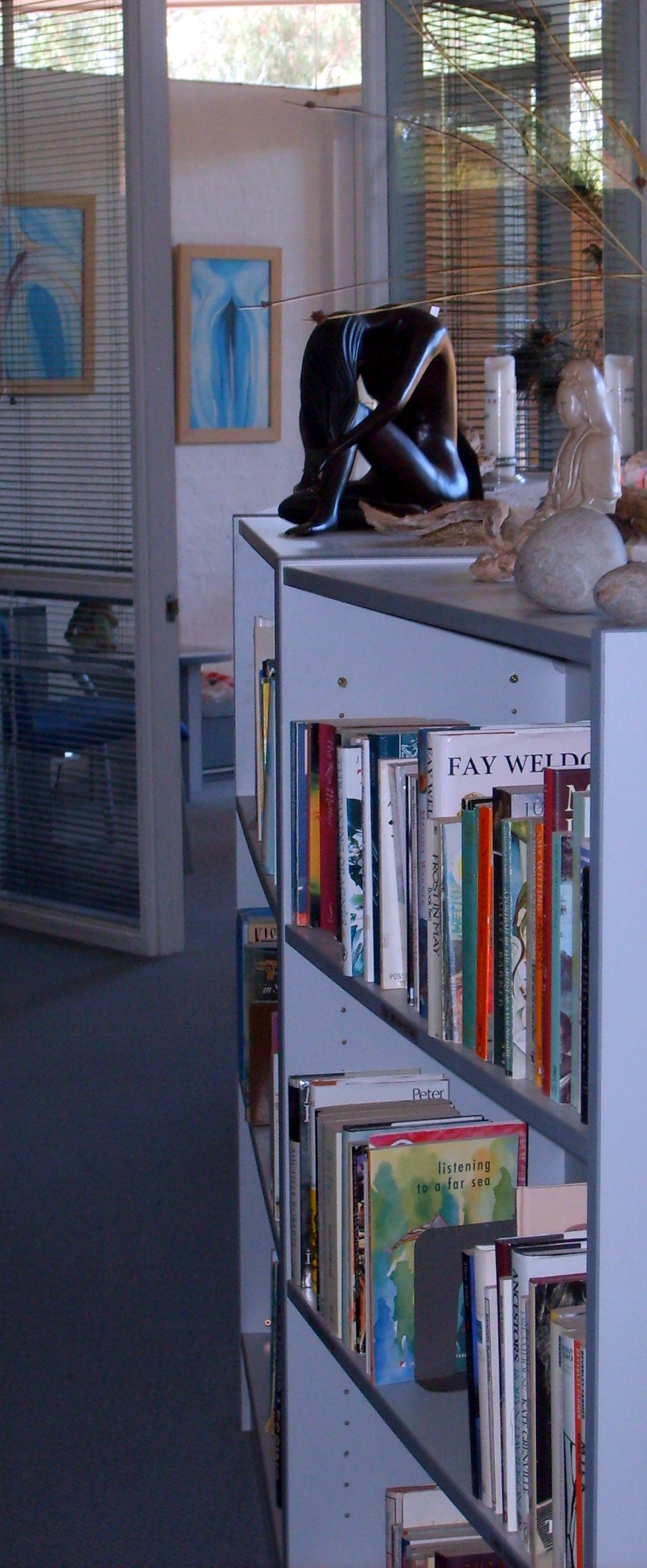The Library
The Sophia Library is a public feminist library of around 3000 items, including books, DVDs, CDs and periodicals. Subject areas include: feminist theology, spiritual life, meditation and ritual, contemporary social issues and women's health, psychology and world religions.
We also have fiction, art books, poetry and biography with a growing focus on indigenous writing.
Membership is open to the general public (see below) and current financial members of Sophia
Browse the Library Catalogue Online
Annual Library Membership
- Full Membership $20.
- Concession $15.
- Membership subscription form
Opening Hours
Tuesday - Friday 10.00am to 4.00pm (Sophia office hours).Volunteering
The Sophia Library is staffed by volunteers. If you would like to volunteer please contact us for more information (see below).Afternoon Tea in the Library
This popular event is held annually, usually in August. A published author speaks about her work, followed by a delicious afternoon tea and sharing of favourite booksPop-Up Book Sale
There is usually a pop-up book sale in the main Sophia meeting room. Items are $2 each and are changed every few weeksDonations are always welcome
'The Sophia Library is a welcoming space and has items you'd be lucky to find in other libraries.'

'As far as I know, the Sophia Library is now the only feminist public library in South Australia.'
Our Location
>
Sophia Library book review
TOXIC The Rotten Underbelly of the Tasmanian Salmon Industry
by Richard Flanagan
[333.72 FLA]
Richard Flanagan is a Booker Prize winning and well known Tasmanian writer. It’s called ‘Toxic’ for good reason and its findings are shocking. The opening page says “ If we purchase the commodity, we participate in the crime”. I did know they feed the salmon grain, some of which is genetically modified because of depletion of wild fish stocks and that negates some of the Omega 3, (which is the main reason we eat salmon) and that they dye the flesh pink for marketing purposes but the environmental, economic and health impacts are more stark than have been identified to the public. The practices of Tassal (in particular), Huon and other smaller companies are exposed along with the government’s complicity because of economic impacts which are huge. Salmon farming is the biggest industry in Tasmania since the decline of forestry. There are also references to Norway and other countries in the food chain. Some of the many worrying issues are: • High overuse of antibiotics because of overcrowding could contribute to human resistance. • The dye used is made from petrochemicals and though they quote many enhancements that only applies to the natural dye and not the synthetic dye, which is the one used in Tasmania • Fish meal mainly from South America is treated with ethoxyquin to prevent self combustion in transit. This is petrochemical based and was originally produced by Monsanto as a pesticide. It accumulates in body fat and can affect baby foetuses. • Soy production for fish food in the Amazon leads to excessive land clearance and most soy production in the world is used in animal fodder. Use of soy leads to reduction of Omega 3 and increase of Omega 6 in the case of salmon farming. • Fish meal is expensive so it is supplemented with guts, beaks, feathers, feet, heads of slaughtered chickens which would have otherwise gone to waste dumps - are used to bulk up the fish food along with soy. • Hormonal and chromosomal breeding practices are used to grow the fish faster and fatter because it results in more profit but they are often deformed and have a painful shorter life but less input, more profit!! Pens are up to 20m deep and are a toxic mix of faeces and urine. RSPCA and WWF endorse salmon production as ethical but are highly paid for their endorsements. • Fresh water is needed to dilute pollution and is taken from terrestrial sources to bathe the fish and then this polluted water is tipped back into marine environments. A lot of this is conducted on huge factory ships which operate 24 hrs per day to clean fish. The noise is constant and in places, locals find it impossible to sleep without earplugs and is causing medical problems. • Tassal’s use of fresh water in 2020 was estimated to be 2 million tonnes and Hobart is the next driest city to Adelaide. The east coast has much lower rainfall than west and that’s where most salmon farming is conducted. Tasmanian waters are the fastest warming seas with climate change and becoming more unsuitable to grow salmon (cool water fish) which are getting more diseases etc so more intervention eg antibiotics are used, some of which flushes into local water affecting quality and other marine animals. • Jellyfish are the principal survivors in the polluted water and now are heading toward dominance in the food chain replacing fish and crustaceans. I haven’t detailed the destruction of Macquarie Harbour which had to be largely abandoned, nor the intimidatory bullying and threats by Tassal on nearby landholders and those who oppose and speak out. Even a critical comment on Facebook has been known to get threatening phone calls. Nor have I mentioned the plan to double production and sites on the east coast, which is very dry reading. This sounds like a sci-fi fantasy and is really scary stuff. Flanagan is a Rhodes Scholar, so I think he would be able to research effectively and maybe wouldn’t put his enviable reputation on the line. If only some of these things were true, it seems a rogue industry and possibly protected because of the potential economic fallout in the poorest state of Australia. Read the book and spread the word. There is so much more information in the book!Mary Raymond and Marian Gray